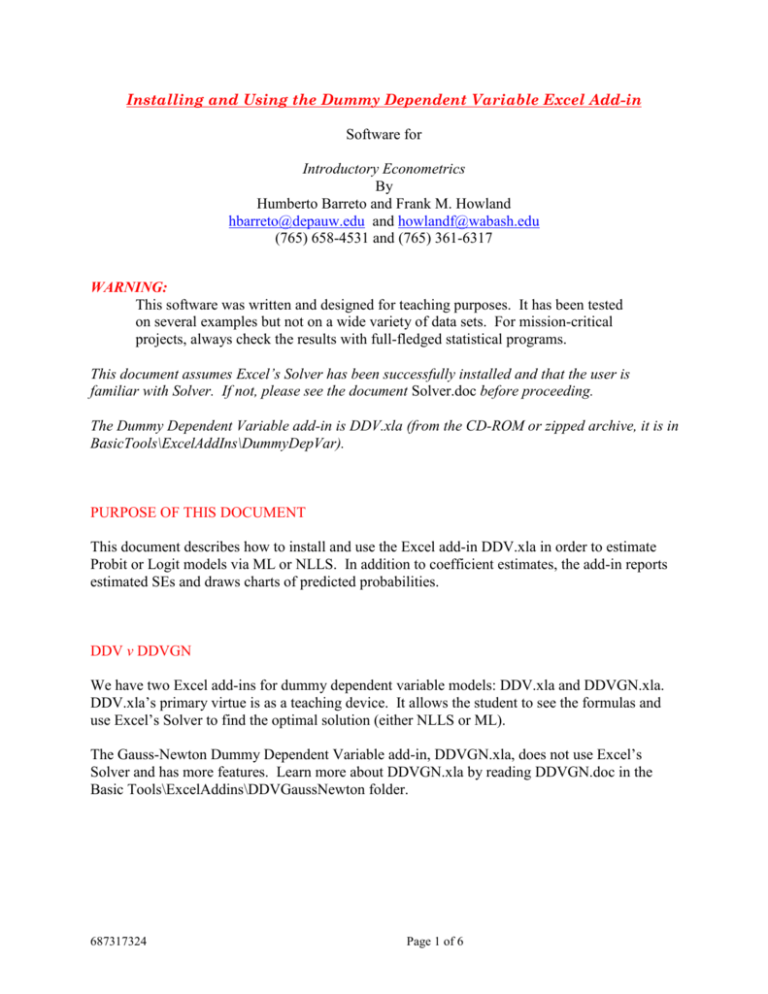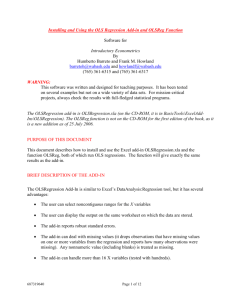Installing and Using the Dummy Dependent Variable Excel Add-in
advertisement

Installing and Using the Dummy Dependent Variable Excel Add-in Software for Introductory Econometrics By Humberto Barreto and Frank M. Howland hbarreto@depauw.edu and howlandf@wabash.edu (765) 658-4531 and (765) 361-6317 WARNING: This software was written and designed for teaching purposes. It has been tested on several examples but not on a wide variety of data sets. For mission-critical projects, always check the results with full-fledged statistical programs. This document assumes Excel’s Solver has been successfully installed and that the user is familiar with Solver. If not, please see the document Solver.doc before proceeding. The Dummy Dependent Variable add-in is DDV.xla (from the CD-ROM or zipped archive, it is in BasicTools\ExcelAddIns\DummyDepVar). PURPOSE OF THIS DOCUMENT This document describes how to install and use the Excel add-in DDV.xla in order to estimate Probit or Logit models via ML or NLLS. In addition to coefficient estimates, the add-in reports estimated SEs and draws charts of predicted probabilities. DDV v DDVGN We have two Excel add-ins for dummy dependent variable models: DDV.xla and DDVGN.xla. DDV.xla’s primary virtue is as a teaching device. It allows the student to see the formulas and use Excel’s Solver to find the optimal solution (either NLLS or ML). The Gauss-Newton Dummy Dependent Variable add-in, DDVGN.xla, does not use Excel’s Solver and has more features. Learn more about DDVGN.xla by reading DDVGN.doc in the Basic Tools\ExcelAddins\DDVGaussNewton folder. 687317324 Page 1 of 6 INSTALLING AND LOADING Microsoft offers the following description of an Excel add-in: Add-ins are programs that add optional commands and features to Microsoft Excel. Before you can use an add-in, you must install it on your computer and then load it in Microsoft Excel. Add-ins (*.xla files) are installed by default in the Library folder in the Microsoft Excel folder. Loading an add-in makes the feature available in Microsoft Excel and adds any associated commands to the appropriate menus. [Microsoft Excel Help, add-ins, overview] Thus, to install an add-in is to have an add-in file (*.xla) in the Library folder of your hard drive. To load it, you must complete an additional step using the Add-In Manager. Fortunately, you need to do this only once. Step 1: Installing the DDV.xla file If you are accessing the DDV.xla add-in from a CD-ROM, place the CD in your computer. If accessing from a network server, make sure you can read from the appropriate network drive. If you do not have CD-ROM or network access to the DDV.xla add-in, download it by visiting <www.wabash.edu/econometrics>. Download the DDV.xla file directly to the appropriate addins folder on your hard drive (usually, C:/Program Files/MicrosoftOffice/Office/Library) or move it there after downloading to your hard drive. Step 2: Loading The DDV.xla add-in Once the DDV.xla file is accessible, launch Excel and use the Add-In Manager to load the Dummy Dependent Variable Analysis add-in. From Excel 2010, click the File menu, then Options, then Add-ins. Excel 2007 is similar, except you click the Office button, then Excel Options, then Add-ins. In previous versions of Excel, click the Tools menu, and then click Add-ins. This screenshot is old. Newer versions of Excel have a similar Add-in Manager dialog box. 687317324 Page 2 of 6 If the Dummy Dep Var Analysis is not listed in the Add-Ins scroll box, click the Browse (or Select) button, navigate to the DDV.xla file on the CD-ROM or network drive, select it, and click OK. Click OK if you are asked to write the DDV.xla file to the Library folder. The Add-In Manager dialog box will now list the Dummy Dep Var Analysis (as depicted above). The Add-In Manager lists all of the installed add-ins, and those with checkmarks are also loaded. Microsoft offers the following advice, “To conserve memory, unload add-ins you do not use often. Unloading an add-in removes its features and commands from Microsoft Excel, but the add-in program remains on your computer so you can easily load it again.” [Microsoft Excel Help, add-ins, overview] In the Add-Ins available scroll box, make sure to select the check box next to the Dummy Dep Var Analysis item (as shown above) and click OK. Excel will load the DDV.xla file and notify you of successful installation with the following message: USING THE DDV.XLA ADD-IN: Using the Dummy Dependent Variable Analysis add-in is easy. Simply click on the Tools menu item and select the Dummy Dep Var Analysis item to acesss a dialog box from which data are provided. Clicking on the Y and X Data buttons brings up input boxes from which you select cells containing the Y and X data: 687317324 Page 3 of 6 Select one, two, three, or all of the four estimation choices and click OK. The DDV.xla add-in uses Excel’s Solver to find the NLLS or ML solution. An important message warns against uncritical acceptance of results: The output is placed in a new sheet in the workbook with the data and looks something like this: For the Probit ML example shown above, the objective function (the sum of the log likelihoods) is in cell A2. The likelihood and log likelihood of each observation are in columns B and C. The coefficients are placed, in order, down column A. The cells in columns B and C contain formulas to verify that the appropriate calculations are being computed and to enable changes to be made if necessary. If Solver does not yield a solution, try different initial values or impose additional constraints. Clicking the Analysis Options button reveals additional options: Selecting the additional options and inputting the appropriate information (the Loan to Appraised Value was used to create the table) yields results like this: 687317324 Page 4 of 6 Sum lnL Likelihood Ln Likelihood -414.903 0.968892 -0.0316 Intercept 0.964897 -0.03573 -6.42957 0.97637 -0.02391 Loan to Appraised 0.975759 Value-0.02454 Ratio 7.759808 0.973183 -0.02718 Estimated Coefficients and SEs Intercept Loan to Appraised Years on Value Job Black Ratio -6.42957 7.759808 -0.01084 0.739094 0.35536 0.425276 0.008603 0.101603 Years on Job0.99607 -0.01084 0.973183 Black 0.996547 0.739094 0.968125 0.968125 0.996365 0.994161 0.972104 0.96688 0.996594 0.995866 0.995452 0.973463 0.96921 0.963549 0.969525 0.968 Predicted Probability Table -0.00394 -0.02718 -0.00346 -0.03239 -0.03239 -0.00364 -0.00586 -0.02829 -0.03368 -0.00341 -0.00414 -0.00456 -0.0269 -0.03127 -0.03713 -0.03095 -0.03252 Years on Job Black Average 9.841 0.505 While varying a particular X value, all other included X variables are held constant at their averages. SDs away Loan to Appraised Predicted Value Probability Ratio -2.5 0.386674 0.000782 Predicted Probability -2 0.458839 0.004628 -1.5 0.531004 0.020552 -1 0.60317 0.069105 1.5 -0.5 0.675335 0.178133 1 0 0.7475 0.358483 0.5 0.819665 0.57827 0.5 1 0.89183 0.775613 0 1.5 0.963996 0.906155 0 0.2 0.4 0.6 0.8 1 2 1.036161 0.969771 Loan to Appraised Value Ratio 2.5 1.108326 0.992604 1.2 The Analysis Options button can be used repeatedly to create many different predicted probability tables. As determined by the data, you may have to clean up the results. For example, the variable Loan to Appraised Value Ratio runs from 50to 100 percent, and so the default set of values in the table from -2.5 to 2.5 standard units are not appropriate. In addition, using the default average of the independent variables does not make sense when it is a dummy variable, and thus the 0.505 Black value should be changed to either a 0 or a 1. Finally, the axes on the chart should be corrected. The cleaned up results look like this: CLEANED UP Predicted Probability Table Years on JobBlack Average 9.841 1 While varying a particular X value, all other included X variables are held constant at their averages. Loan to Appraised Predicted Value Ratio Probability 0.5 0.08% Black Predicted Probability of Loan Denial 0.55 0.46% 0.6 2.06% 100.00% 0.65 6.91% 75.00% 0.7 17.81% 50.00% 0.75 35.85% 0.8 57.83% 25.00% 0.85 77.56% 0.00% 0.9 90.62% 0 0.2 0.4 0.6 0.8 0.95 96.98% Loan to Appraised Value Ratio 1 99.26% 687317324 Page 5 of 6 1 THIS VERSION The latest DDV.xla version is 10 June 2010 To check the date of your installed add-in, access the Add-Ins manager dialog box and then highlight the add-in. The Add-Ins dialog box displays the date at the bottom. . To install this for the first time, please follow the instructions on the first page of this document. To install over a previous version that is already installed, please see InstallingAddinOverPreviousVersion.doc for detailed instructions. The procedure is basically this: To install over a previous version, quit Excel and simply drag this new version into the Excel Add-ins folder. If you do not know where this folder is, search for “DDV.xla” and then drag the new version over the old one. Of course, you will want to accept rewriting over the previous version. Launch Excel and you are ready to use the add-in. ADDITIONAL HELP AND FEEDBACK: If something goes wrong in the installation or loading process, an unexpected error keeps recurring, or you have other problems, please contact us. Many problems are fixed by uninstalling (unchecking in the Add-ins Manager, clicking OK) and reinstalling. We are interested in your comments, suggestions, or criticisms of the DDV.xla software. www.wabash.edu/econometrics Humberto Barreto DePauw University hbarreto@depauw.edu (765) 658-4531 687317324 Frank Howland Wabash College howlandf@wabash.edu (765) 361–6317 Page 6 of 6









